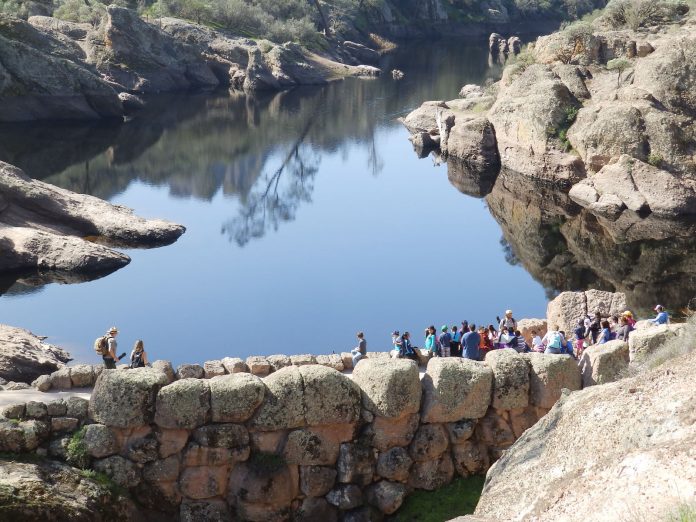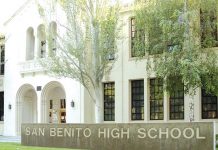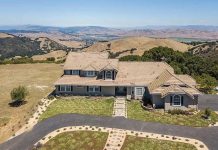National Park Service Ranger Sierra Willoughby stopped the second grade students in a clearing surrounded by trees stretching many times their height and asked them what they heard.
“Birds!,” shouted a student.
The youth from Del Rey Elementary School in King City were standing in Pinnacles National Park feet away from a dead tree that held hundreds of acorns stashed away by industrious woodpeckers.
The park is home to the highest known bee diversity per unit area of any studied place on the planet, orange rock formations that reach for the sun and the famous California Condors.
It’s also one of San Benito County’s best-kept secrets. An estimated 400,000 people visit the park each year, according to the supervisor of fee collections.Many were visiting from neighboring counties. But since the site became a national park, a growing number are trekking in from out of state so they can say they’ve seen all 59 national parks, including Pinnacles, the newest addition.
Visitor spent $4.8 million in the park or within a 50-mile radius of the site in 2013, according to a Pinnacles National Park report detailing the latest economic data. The greatest proportion of the expenditures––or 32 percent––was for overnight accommodations in tents, lodges, hotels, motels, cabins or bed and breakfasts.
Greg Harvey, co-owner of Joshua Inn Bed & Breakfast on 712 West St. in Hollister, called the national park “huge” for business.
“At least 75 percent of the folks that are staying here, if you ask them if there’s a special occasion they’re staying for, they’re coming to see the Pinnacles or at least it’s part of the trip,” Harvey said. “Since it became a national park it’s been a big deal.”
Teacher Yvonne Voigt, who brought her class of second graders outside to breathe the fresh air, see wildernessandlearn about the nature they study in school, likes that students visiting the park see a diverse swatch of the California outdoors.
“They get to see the meadows and the cows grazing. They get to see the rocks,” said the teacher. “And they get to experience hiking.”
Located just 45 minutes outside of Hollister, the drive to the park is a journey in and of itself as Highway 25 turns into Airline Highway and winds through San Benito County’s back country, where weathered old barns dot pastures of grazing cattle, past a rural public school that serves about a dozen students,and through a flat section where fog hugs the asphalt in the morning making mist, grass and road stretch as far as the eye can see.
The towns along the way are small with Tres Pinos, the first stop outside of Hollister, boasting a population of 476 people. The side streets branching off the mainroute to the parkdisplay such names as “Quien Sabe Road”—Spanish for “who knows” —and “Best Road.”
Pinnacles was first declared a monument in 1908 but was upgraded to one of America’s jewels with national park status in 2013.
On Feb. 19, Ranger Willoughby took students on a hike through groves of trees, up dusty switchbacks to a glistening man-made reservoir put in place before the area became a national park and left there because it provides a home to the rare California Red-legged Frogs. As they hiked, he asked the students to name things animals leave behind.
“Shadows!” answered a student, who took the question literally.
“Yeah, you might see a big condor fly between us and the sun,” said the ranger. “That’d be a big shadow.”
This group of students was one of the first visiting the park this year, but it won’t be the last. Each year, park rangers guide students on field trips so they can to hike the trails, glimpse the site’s famous rock formations, see the caves and “look but not touch”when they pass interesting rocks and flowers.
For teachers such as Voigt, taking students outside fits right into the state’s new Common Core standards, which emphasize learning by inquiry and working collaboratively on group projects.
“Common Core wants the kids to be thinking and speaking more, and field trips are great for that,” she said.
Voigt chaperoned classes of students through the park long before it was a national attraction, and now the higher designation is just one more thing her students can brag about when they return home. Her colleague second grade teacher Chip Kosty, an avid rock climber, also knows the park well.
“I like the trails,” Kosty said. “I like the fact you can get some really good exercise here going up and down hills.”
As Voigt climbed an incline, she looked at the switchbacks above where her students clambered toward moss-covered boulders.
“Everybody is so happy to be out in nature,” Voigt said. “It’s like your heartbeat gets in rhythm with nature.”
FAST FACTS:
1) Pinnacles National Park has the largest number of bee species per unit area of any place ever studied. About 400 bee species have been counted at the park, which is just 25 square miles in area.
2) California condors have a more than nine-foot long wingspan and can glide at up to 55 mph.
3) The park is home to 14 of the 24 bat species living in California.
PINNACLES VISITOR SPENDING BY CATEGORY:
Motels: 26 percent
Gas and oil: 24 percent
Restaurants and bars: 17 percent
Groceries and takeout food: 14 percent
Camping fees: 6 percent
Admission and fees: 6 percent
Souvenirs and other expenses: 6 percent
Local transportation: 1 percent
Did You Know?
CRITTERS YOU COULD SEE: California condor, Bald eagle, Golden eagle, Peregrine Falcon, Long-eared owl, Townsend’s big-eared bat, American badger, black-tailed deer, bobcat, grey fox, chipmunk, raccoon, brush rabbit, coyotes
THINGS TO BRING: Water, snacks, camera, closed-toed shoes, map, sunscreen, cash for park fees
TIP: Cell phone reception is poor within the park so plan to meet up with other hikers at a specific time and place. Take a paper map from the visitor center along for the hike.
BEFORE YOU GO: There is a west and an east entrance and no road through the park connecting the two sides. Most GPS units will automatically route visitors to the West Pinnacles entrance, which is home to the Pinnacles Visitor Contact Station. The East Side of the park holds the Pinnacles Visitor Center.
Directions from the San Francisco Bay Area to the East Entrance:
Take Highway 101 South through the city of Gilroy to Highway 25 South. On Highway 25, go through the town of Hollister and continue about 30 miles to Highway 146. Turn right on Highway 146, then turn left into the Pinnacles Campground to check in at Pinnacles Visitor Center. From the campground, the Bear Gulch Area is 3.5 miles further into the park along Highway 146.
Directions from the San Francisco Bay Area to the West Entrance:
Take Hwy 101 south to the town of Soledad, and then take Highway 146 east. Take care as you’re driving through town; the highway takes a few turns. Follow Highway 146 for 14 miles into Pinnacles National Park.
For more information, go to nps.gov/pinn.
FEES:
Vehicle pass (valid for 7 days): $10
Individual person on foot or bike (valid for 7 days): $5
Pinnacles National Park Annual Pass: $20










